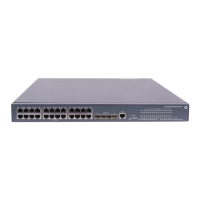193
Ste
Command
Remarks
3. Enter Ethernet interface
view or port group view.
• Enter Layer 2 Ethernet interface view:
interface interface-type interface-number
• Enter port group view:
port-group manual port-group-name
Use either command.
4. Enable LLDP.
lldp enable
Optional.
By default, LLDP is enabled on
a port.
Setting the LLDP operating mode
LLDP can operate in one of the following modes.
• TxRx mode—A port in this mode sends and receives LLDPDUs.
• Tx mode—A port in this mode only sends LLDPDUs.
• Rx mode—A port in this mode only receives LLDPDUs.
• Disable mode—A port in this mode does not send or receive LLDPDUs.
To set the LLDP operating mode:
Ste
Command
Remarks
1. Enter system view.
system-view N/A
2. Enter Ethernet interface
view or port group view.
• Enter Layer 2 Ethernet interface view:
interface interface-type interface-number
• Enter port group view:
port-group manual port-group-name
Use either command.
3. Set the LLDP operating
mode.
lldp admin-status { disable | rx | tx | txrx }
Optional.
TxRx by default.
Setting the LLDP re-initialization delay
When LLDP operating mode changes on a port, the port initializes the protocol state machines after a
certain delay. By adjusting the LLDP re-initialization delay, you can avoid frequent initializations caused
by frequent changes to the LLDP operating mode on a port.
To set the LLDP re-initialization delay for ports:
Ste
Command
Remarks
1. Enter system view.
system-view N/A
2. Set the LLDP re-initialization
delay.
lldp timer reinit-delay delay
Optional.
2 seconds by default.
Enabling LLDP polling
With LLDP polling enabled, a device periodically searches for local configuration changes. On detecting
a configuration change, the device sends LLDPDUs to inform neighboring devices of the change.

